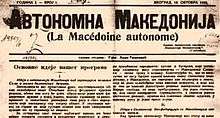Macedonians in Serbia
| Македонци у Србији | |
|---|---|
| Total population | |
| 22,755 (2011) | |
| Languages | |
| Macedonian, Serbian | |
| Religion | |
| Macedonian Orthodox Church, Serbian Orthodox Church | |
| Related ethnic groups | |
| Bulgarians and other South Slavs |
Macedonians of Serbia are an officially recognized ethnic minority in Serbia.
History

During the years 1945–1992, ethnic Macedonians and the Macedonian Language was a constituent part of the Socialist Federal Republic of Yugoslavia. Many Ethnic Macedonians, due to economic reasons, migrated during the 1960s and 1970s to the Socialist Republic of Serbia (predominately in Vojvodina). In 2004, Serbia and Macedonia signed an inter-state agreement on the protection of Macedonians in Serbia and Serbs in Macedonia.
| Historical population | ||
|---|---|---|
| Year | Pop. | ±% |
| 1948 | 17,907 | — |
| 1953 | 27,277 | +52.3% |
| 1961 | 36,288 | +33.0% |
| 1971 | 42,675 | +17.6% |
| 1981 | 48,986 | +14.8% |
| 1991 | 45,068 | −8.0% |
| 2002 | 25,847 | −42.6% |
| 2011 | 22,755 | −12.0% |
| From 1991, the census was not conducted on the territory of Kosovo[lower-alpha 1] Source: [1] | ||
Demographics
According to the 2011 census there were 22,755 ethnic Macedonians in Serbia.[2] The Macedonian population living in Serbia is concentrated in two cities, Belgrade and Pančevo. In Belgrade there are 6,970 Macedonians, while in neighboring Pančevo 4,558 - out of which vast majority live in three villages (Jabuka, Glogonj, and Kačarevo) that are within administrative limits of City of Pančevo. Additionally, Macedonians constitute significant population in Plandište municipality, especially in village of Dužine.
Politics
In 2005 Macedonians in Serbia also established a National Minority Council, which represents as a step towards safeguarding their interests. Jovo Radevski was elected as its president. The Democratic Party of Macedonians is the primary minority party. It is centered in Novi Sad.
| Part of a series on |
| Macedonians |
|---|
 |
| By region or country |
| Macedonia (region) |
| Diaspora |
|
|
|
|
|
Subgroups and related groups |
|
|
| Culture |
|
|
| Religion |
| Other topics |
Culture
Macedonian language is in the official use in the municipality of Plandište, where Macedonians constitute 9.2% of population. Macedonian-language print media consists primarily of the monthly political journal Makedonska videlina produced by the Macedonian Information and Publishing Centre in Pančevo. Limited Macedonian-language television is available through regional public broadcaster of Radio Television of Vojvodina and the local station TV Pančevo.
Associations such as "The Society of Serbian and Macedonian Friendship Šar – planina" seated in Belgrade, and the "Municipal Society of Serbian-Macedonian Friendship" seated in Zrenjanin cover issues related to ethnic, cultural and economic cooperation in Serbia.
Notable people
- Vladimir Gligorov, Serbian economist, of Macedonian parentage
- Aleksandar Džambazov, Yugoslav, Serbian and Macedonian composer, of Macedonian ancestry
- Ivica Iliev, Serbian footballer, of Macedonian ancestry
- Maja Odžaklievska, Serbian singer, born in Skopje
- Zafir Hadžimanov, musician
- Vasil Hadžimanov, jazz musician
- Tijana Dapčević, Serbian and Macedonian pop singer, born in Skopje to Macedonian father and Bosnian Serb mother
- Bogomil Gjuzel, Macedonian poet, writer, playwright and translator, born in Serbia to Macedonian Bulgarian father
- Zoran Vanev, Serbian and Macedonian turbo-folk singer, born in Štip and lives in Belgrade
- Aleksandar Ignjovski, Serbian footballer, of Macedonian ancestry
- Marko Pavlovski, Serbian footballer of Macedonian ancestry
- Ana Sinicki, famous mezzo-soprano[3]
- Zvonko Mihajlovski, Serbian sports commentator and former hockey player, born in Štip and lives in Belgrade
References
- ↑ Kosovo is the subject of a territorial dispute between the Republic of Kosovo and the Republic of Serbia. The Republic of Kosovo unilaterally declared independence on 17 February 2008, but Serbia continues to claim it as part of its own sovereign territory. The two governments began to normalise relations in 2013, as part of the Brussels Agreement. Kosovo has received formal recognition as an independent state from 113 out of 193 United Nations member states.
- ↑ "2011 Census of Population, Households and Dwellings in the Republic of Serbia" (PDF). stat.gov.rs. Statistical Office of the Republic of Serbia. Archived from the original (PDF) on 14 July 2014. Retrieved 15 January 2017.
- ↑ "Archived copy" (PDF). Archived from the original (PDF) on 2014-08-11. Retrieved 2015-06-02.
- ↑ Ана Синицки: Сакам да ме запознае македонската публика
External links
- www.mhrmi.org-Website for Macedonian International Rights
- Association of Macedonians from Vranje
- Democratic Party of Macedonians
.svg.png)
